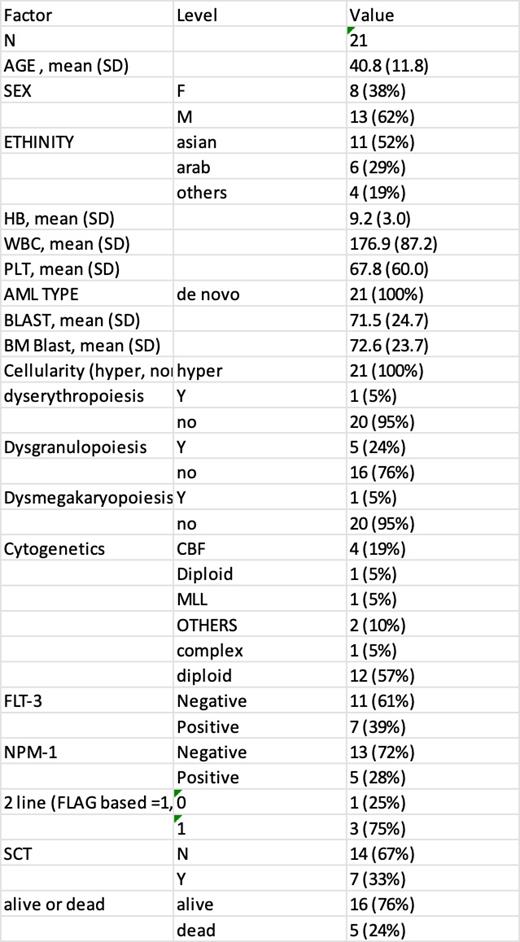Background
Hyperleukocytosis is the condition where Acute myeloid leukemia (AML) is presented with white blood cell counts equal to or greater than 100,000. A small proportion of AML patients are presented with this condition which is associated with significant morbidity and mortality caused by related serious complications including leukostasis, tumor lysis syndrome (TLS) and disseminated intravascular coagulation. Hyperleukocytosis is a hematological emergency requiring immediate intervention.
In this retrospective study we describe the general characteristics, cytogenetics, mutational profile, treatment given, and outcome of AML patients having hyperleukocytosis at diagnosis.
Methods
Data were retrieved from the clinical data base of our tertiary cancer center (National Center for Cancer Care and Research, Doha, Qatar). All patients with AML diagnosed during the period January 2017 through December 2021 were included.
Results
A total of 186 AML patients were included. Twenty-one patients (11.5%) were presented with hyperleukocytosis. Males were more predominant 13/21 (62 %) and more than half of the patients had an Asian origin 52%. The median age for the group was 40.0 years (18-89). Complete blood count (CBC) showed median hemoglobin of 9.2g/dl, white blood cells of 176x10^3/uL and platelets 6x10^3/uL. the median percentage of the blast in the peripheral blood was 71 % and 72 % in bone marrow. Bone marrow cellularity was high in all the cases 100%. Bone marrow dysplasia was assessed with dysgranulopoiesis observed in 24%. All patients had de novo AML. In these patients the diploid KT was most common cytogenetic findings (57%), followed by CBF recurrent cytogenetics abnormalities in 4 patients (19%). FLT 3-ITD was positive in 7 patients (33%) and NPM1 mutation in 5 patients (28%). Hydroxyurea (HU) was used as cytoreductive therapy in 90% of patients. More than half of the patients 11/21 (52%) were admitted to intensive care unit (ICU). One patient had CNS relapse. Seven patients (33%) underwent allogenic bone marrow transplant. Progression occurred in 6 patients 28 (median1.4 years) and Overall survival in this cohort was 76 % (median1.9 year) and the average duration of follow-up of 24.8 months. Early death within 30 days observed, with median time to death 4 days (1-12) among those who died.
Conclusion
One of ten AML patients are presented with hyperleukocytosis. Most of our AML patients with hyperleukocytosis were young males. This is most probably related to the young general population in our country. All patients had hypercellular marrow with high blast percentage. Diploid Karyotype, CBF rearrangements, FLT 3-ITD mutation and NPM1 mutation were frequent in this cohort. Most of the patients developed complications requiring intensive care admission. Hydroxyurea was the first choice for cytoreduction. Both disease progression and mortality were relatively high (28% and 24 % respectively) and occurred very early, within less than a week from presentation. Early diagnosis and immediate management are mandatory to tackle the complications of this hematological emergency and improve morbidity and mortality.
Disclosures
No relevant conflicts of interest to declare.


This feature is available to Subscribers Only
Sign In or Create an Account Close Modal